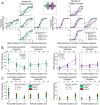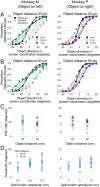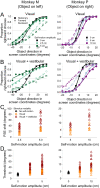Optic flow parsing in the macaque monkey
- PMID: 33016983
- PMCID: PMC7545062
- DOI: 10.1167/jov.20.10.8
Optic flow parsing in the macaque monkey
Abstract
During self-motion, an independently moving object generates retinal motion that is the vector sum of its world-relative motion and the optic flow caused by the observer's self-motion. A hypothesized mechanism for the computation of an object's world-relative motion is flow parsing, in which the optic flow field due to self-motion is globally subtracted from the retinal flow field. This subtraction generates a bias in perceived object direction (in retinal coordinates) away from the optic flow vector at the object's location. Despite psychophysical evidence for flow parsing in humans, the neural mechanisms underlying the process are unknown. To build the framework for investigation of the neural basis of flow parsing, we trained macaque monkeys to discriminate the direction of a moving object in the presence of optic flow simulating self-motion. Like humans, monkeys showed biases in object direction perception consistent with subtraction of background optic flow attributable to self-motion. The size of perceptual biases generally depended on the magnitude of the expected optic flow vector at the location of the object, which was contingent on object position and self-motion velocity. There was a modest effect of an object's depth on flow-parsing biases, which reached significance in only one of two subjects. Adding vestibular self-motion signals to optic flow facilitated flow parsing, increasing biases in direction perception. Our findings indicate that monkeys exhibit perceptual hallmarks of flow parsing, setting the stage for the examination of the neural mechanisms underlying this phenomenon.
Figures












Similar articles
-
Multisensory Integration of Visual and Vestibular Signals Improves Heading Discrimination in the Presence of a Moving Object.J Neurosci. 2015 Oct 7;35(40):13599-607. doi: 10.1523/JNEUROSCI.2267-15.2015. J Neurosci. 2015. PMID: 26446214 Free PMC article.
-
A neural mechanism for optic flow parsing in macaque visual cortex.Curr Biol. 2024 Nov 4;34(21):4983-4997.e9. doi: 10.1016/j.cub.2024.09.030. Epub 2024 Oct 9. Curr Biol. 2024. PMID: 39389059
-
A Neural Model of MST and MT Explains Perceived Object Motion during Self-Motion.J Neurosci. 2016 Aug 3;36(31):8093-102. doi: 10.1523/JNEUROSCI.4593-15.2016. J Neurosci. 2016. PMID: 27488630 Free PMC article.
-
Walking humans and running mice: perception and neural encoding of optic flow during self-motion.Philos Trans R Soc Lond B Biol Sci. 2023 Jan 30;378(1869):20210450. doi: 10.1098/rstb.2021.0450. Epub 2022 Dec 13. Philos Trans R Soc Lond B Biol Sci. 2023. PMID: 36511417 Free PMC article. Review.
-
How Optic Flow and Inertial Cues Improve Motion Perception.Cold Spring Harb Symp Quant Biol. 2014;79:141-8. doi: 10.1101/sqb.2014.79.024638. Cold Spring Harb Symp Quant Biol. 2014. PMID: 26092884 Review.
Cited by
-
Investigating distortions in perceptual stability during different self-movements using virtual reality.Perception. 2022 Aug 9;51(10):3010066221116480. doi: 10.1177/03010066221116480. Online ahead of print. Perception. 2022. PMID: 35946126 Free PMC article.
-
Seeing a Three-Dimensional World in Motion: How the Brain Computes Object Motion and Depth During Self-Motion.Annu Rev Vis Sci. 2025 Jun 18:10.1146/annurev-vision-110323-112124. doi: 10.1146/annurev-vision-110323-112124. Online ahead of print. Annu Rev Vis Sci. 2025. PMID: 40532119 Free PMC article. Review.
-
A neural mechanism for detecting object motion during self-motion.Elife. 2022 Jun 1;11:e74971. doi: 10.7554/eLife.74971. Elife. 2022. PMID: 35642599 Free PMC article.
-
Binocular contributions to motion detection and motion discrimination during locomotion.PLoS One. 2024 Dec 20;19(12):e0315392. doi: 10.1371/journal.pone.0315392. eCollection 2024. PLoS One. 2024. PMID: 39705227 Free PMC article.
-
Flexible computation of object motion and depth based on viewing geometry inferred from optic flow.bioRxiv [Preprint]. 2025 May 19:2024.10.29.620928. doi: 10.1101/2024.10.29.620928. bioRxiv. 2025. PMID: 40475437 Free PMC article. Preprint.
References
-
- Albright T. D. (1989). Centrifugal directional bias in the middle temporal visual area (MT) of the macaque. Visual Neuroscience, 2(2), 177–188. - PubMed
-
- Benson A. J., Spencer M. B., & Stott J. R. (1986). Thresholds for the detection of the direction of whole-body, linear movement in the horizontal plane. Aviation, Space, and Environmental Medicine, 57(11), 1088–1096. - PubMed
-
- Bradley D. C., Maxwell M., Andersen R. A., Banks M. S., & Shenoy K. V. (1996). Mechanisms of heading perception in primate visual cortex. Science, 273(5281), 1544–1547. - PubMed
Publication types
MeSH terms
Grants and funding
LinkOut - more resources
Full Text Sources

